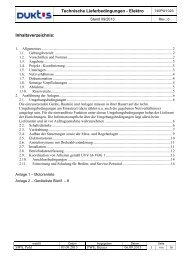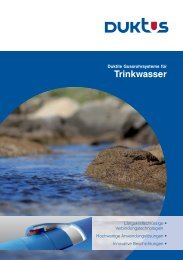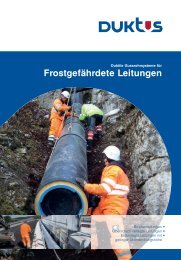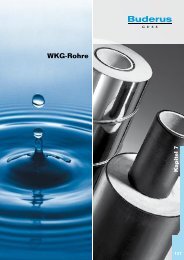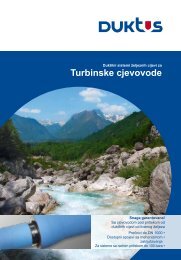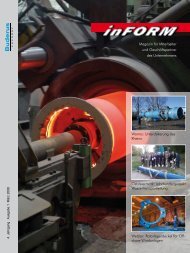Buderus Manual on Trenchless Installation of Ductile Cast ... - Duktus
Buderus Manual on Trenchless Installation of Ductile Cast ... - Duktus
Buderus Manual on Trenchless Installation of Ductile Cast ... - Duktus
Create successful ePaper yourself
Turn your PDF publications into a flip-book with our unique Google optimized e-Paper software.
Other pluses that the two techniques have are these:<br />
General<br />
• There is no need for public-transport bus stops to be moved (see Fig. 3.3).<br />
• There is almost no interference with delivery traffic in streets where there are business<br />
premises.<br />
• Other utilities carried in pipes are not put at risk by excavati<strong>on</strong> work.<br />
• Depending <strong>on</strong> the machinery used, whose maximum sound emissi<strong>on</strong> is less than .<br />
dB(A), the installati<strong>on</strong> work is particularly „quiet“ and free <strong>of</strong> dust. It is even possible<br />
for work in residential areas to c<strong>on</strong>tinue without any overnight breaks.<br />
Above all when installati<strong>on</strong> work is being d<strong>on</strong>e in inner city areas, where there are very<br />
closely packed runs <strong>of</strong> pipe, intersecting pipelines and pipelines running in parallel are<br />
very much at risk when heavy-duty digging equipment is used in open trenches. This risk<br />
is cut to a minimum when trenchless replacement techniques are employed.<br />
The two techniques can both be used for supply pipelines <strong>of</strong> nominal sizes ranging from<br />
DN 80 to DN 00. What are required are:<br />
• a machine pit to hold the machinery,<br />
• an installati<strong>on</strong> pit (about 7 metres l<strong>on</strong>g) for the new pipes,<br />
• intermediate pits for the house c<strong>on</strong>necti<strong>on</strong>s or branch pipelines.<br />
The distance between the intermediate pits depends <strong>on</strong> the nominal size <strong>of</strong> the old pipeline<br />
and <strong>on</strong> the c<strong>on</strong>diti<strong>on</strong> it is in, <strong>on</strong> the nominal size <strong>of</strong> the new pipeline, <strong>on</strong> the machinery<br />
used, <strong>on</strong> the nature <strong>of</strong> the soil, <strong>on</strong> the trees present and their roots and <strong>of</strong> course <strong>on</strong><br />
the c<strong>on</strong>diti<strong>on</strong>s relating to traffic and the medium involved. Depending <strong>on</strong> the technique<br />
and the locality, the distance between the intermediate pits should not be more than 2<br />
to 0 metres. With a straight run <strong>of</strong> pipes or <strong>on</strong>e with a radius <strong>of</strong> curvature <strong>of</strong> not more<br />
than 170 metres, the distance between the launch and arrival pits is normally from 100<br />
to 180 metres. Before the replacement operati<strong>on</strong>, the old pipeline has to be taken out<br />
<strong>of</strong> service. The supply <strong>of</strong> the adjacent houses and other premises is maintained through<br />
temporary interim pipelines, the water from which is fed into the house c<strong>on</strong>necting<br />
pipes, the ends <strong>of</strong> which have been closed <strong>of</strong>f, in the pits for the house c<strong>on</strong>necti<strong>on</strong>s.<br />
3



